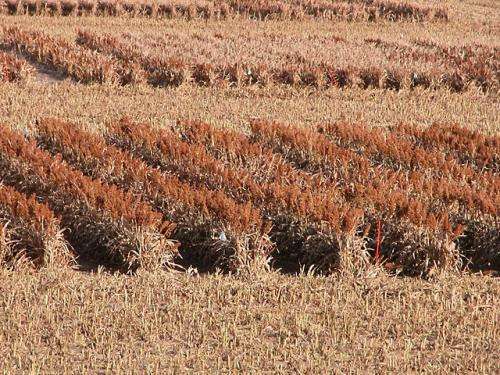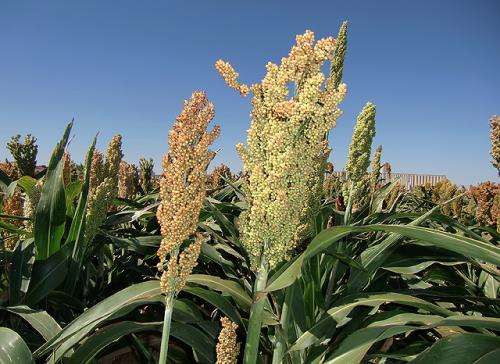Scientists develop higher yielding sorghum plants

When it comes to versatile crop plants, sorghum might be considered "the little engine that could."
It is drought tolerant, can thrive in poor soils, requires little or no fertilizer, and will grow in a wide range of temperatures and altitudes. Sorghum grain is used in breakfast cereals, in ethanol production, as feed for livestock, as a source of sugar for syrup and molasses, and in construction and packaging materials. It also produces large amounts of plant material, making it potentially useful for cellulosic ethanol production.
"There are parts of the world where people depend on sorghum for their survival, but in the United States, it's a viable alternative crop for growers concerned about future droughts or the rising temperatures that might accompany climate change," says Merle Vigil, an Agricultural Research Service soil scientist and research leader in the Central Plains Resources Management Research Unit in Akron, Colorado.
Sorghum is also the focus of extensive research, and Vigil along with ARS researcher Greg McMaster and Colorado State University researchers Sally Sauer and Jerry Johnson, recently found a new way to exploit sorghum's potential. They found that by using certain cropping strategies, growers can produce sorghum in parts of northeastern Colorado where the growing season was previously considered too short. Meanwhile, another team of ARS scientists working in Texas has developed a new line of sorghum that could dramatically increase grain yields.
The work is considered important because of sorghum's value as a cash crop and because its drought tolerance is likely to make it a critical option in future efforts to stave off global hunger in semi-arid areas. In the United States, sorghum is grown in 14 states on 7.2 million acres, production that was valued at $1.6 billion in 2013. Most U.S. sorghum is used to feed livestock. But in Africa and Asia it is a major part of the human diet. Worldwide, the land area dedicated to sorghum production has increased by 66 percent over the past 50 years.
Coping with Climate Change

Cool evening temperatures in the spring and cold temperatures in the early fall make the growing season in northeastern Colorado too short to raise the sorghum varieties grown in southern Colorado. Northeastern farmers plant corn rather than sorghum, often rotating it with winter wheat. But irrigation is rare in the region, and sorghum would be a good option, since it is more drought tolerant and less expensive to produce than corn.
To find the optimal conditions for producing sorghum in northeastern Colorado, Vigil and his colleagues at Colorado State University studied several factors known to affect plant maturity, including seeding density, hybrid selection, row spacing, and row orientation (a north-south or east-west orientation).
The researchers grew two early-maturing sorghum varieties and one "medium-early" maturing variety in test plots at Fort Collins, Akron, and Stratton. The three sites are up to 200 miles apart and represent a range of environments. They planted in the spring and harvested in late fall for 2 years. Based on planting dates and temperature data, they determined the number of "growing degree-days" (GDDs) needed for plants to reach maturity at each site. They also used historical weather data to calculate probabilities that the sites would experience the required number of GDDs in a growing season for plants to reach maturity.
The results showed that sorghum is a viable option for northern Colorado growers if they use an early-maturing hybrid. Yields reached acceptable levels at all three sites, but weather data showed sufficient growing seasons would be more likely in Stratton and Akron than at Fort Collins, which was the most northern and most elevated site. They also found that fields should be seeded at a rate of about 11 seeds per square meter (the mid-range of the three seeding rates evaluated). Row orientation and row spacing had inconsistent effects on maturity rates.
Higher Yielding Sorghum Plants
In other sorghum studies, molecular biologist Zhanguo Xin, plant geneticist Gloria Burow, and lab director John Burke, at the ARS Cropping Systems Research Laboratory in Lubbock, Texas, have bred a mutant sorghum plant that produces 30 to 40 percent more seeds.
The researchers developed the higher yielding sorghum by taking advantage of a plant part called a "spikelet." A spikelet is a cluster of florets found in the panicle and is a characteristic of other grasses, such as millet or rye. Sorghum produces two types of spikelets: the sessile spikelets and the pedicellate spikelets. Normally, only the sessile spikelets are fertile, but the ARS scientists developed a plant that produces seeds in both types of spikelets.
"We developed the productive sorghum line by inducing a mutation of sorghum plants that allowed infertile spikelets to grow and produce seed," says Xin. An induced mutation is produced by treatment with a mutagen, like radiation or a chemical agent such as ethyl methane sulfonate. The mutation resulted in an overall increase in size and volume (length, width, and thickness) of the sorghum panicle.
"All of the spikelets of the new sorghum plant develop into flowers and produce mature seeds, thereby significantly increasing seed production and yield in comparison to conventional sorghum. The mutants may be crossed with other sorghum lines, particularly elite large-seeded lines, to improve grain yield in sorghum and other related species," says Xin. "The mutation in the sorghum line we developed is stable and can be passed on to other sorghum lines through breeding."
A sample of at least 2,500 seeds of the new multi-seeded sorghum has been deposited with the American Type Culture Collection for future research.
Provided by Agricultural Research Service


















